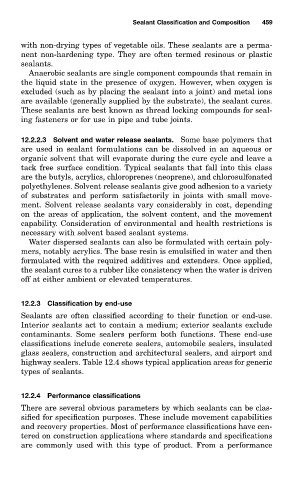Page 532 - Handbook of Adhesives and Sealants
P. 532
Sealant Classification and Composition 459
with non-drying types of vegetable oils. These sealants are a perma-
nent non-hardening type. They are often termed resinous or plastic
sealants.
Anaerobic sealants are single component compounds that remain in
the liquid state in the presence of oxygen. However, when oxygen is
excluded (such as by placing the sealant into a joint) and metal ions
are available (generally supplied by the substrate), the sealant cures.
These sealants are best known as thread locking compounds for seal-
ing fasteners or for use in pipe and tube joints.
12.2.2.3 Solvent and water release sealants. Some base polymers that
are used in sealant formulations can be dissolved in an aqueous or
organic solvent that will evaporate during the cure cycle and leave a
tack free surface condition. Typical sealants that fall into this class
are the butyls, acrylics, chloroprenes (neoprene), and chlorosulfonated
polyethylenes. Solvent release sealants give good adhesion to a variety
of substrates and perform satisfactorily in joints with small move-
ment. Solvent release sealants vary considerably in cost, depending
on the areas of application, the solvent content, and the movement
capability. Consideration of environmental and health restrictions is
necessary with solvent based sealant systems.
Water dispersed sealants can also be formulated with certain poly-
mers, notably acrylics. The base resin is emulsified in water and then
formulated with the required additives and extenders. Once applied,
the sealant cures to a rubber like consistency when the water is driven
off at either ambient or elevated temperatures.
12.2.3 Classification by end-use
Sealants are often classified according to their function or end-use.
Interior sealants act to contain a medium; exterior sealants exclude
contaminants. Some sealers perform both functions. These end-use
classifications include concrete sealers, automobile sealers, insulated
glass sealers, construction and architectural sealers, and airport and
highway sealers. Table 12.4 shows typical application areas for generic
types of sealants.
12.2.4 Performance classifications
There are several obvious parameters by which sealants can be clas-
sified for specification purposes. These include movement capabilities
and recovery properties. Most of performance classifications have cen-
tered on construction applications where standards and specifications
are commonly used with this type of product. From a performance

